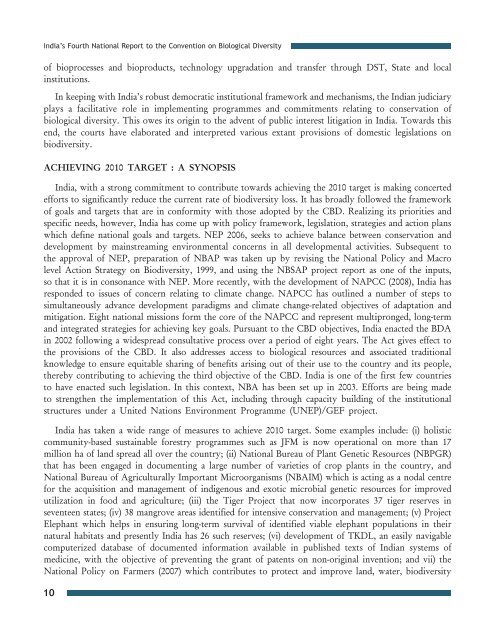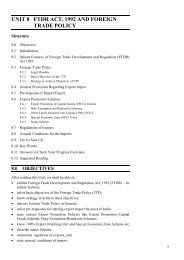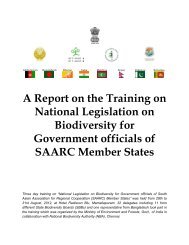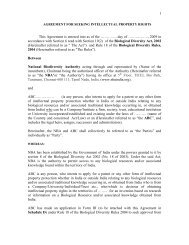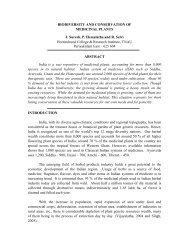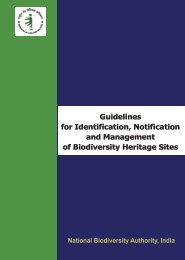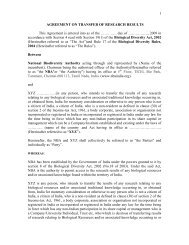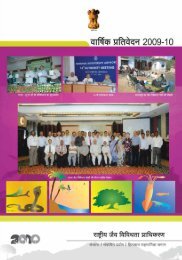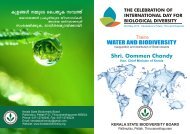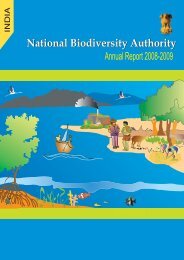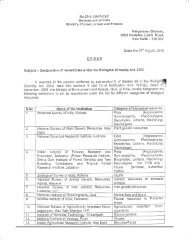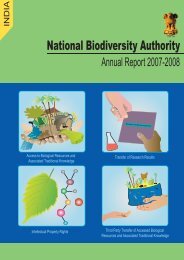Part 1 - English version (PDF) - Convention on Biological Diversity
Part 1 - English version (PDF) - Convention on Biological Diversity
Part 1 - English version (PDF) - Convention on Biological Diversity
Create successful ePaper yourself
Turn your PDF publications into a flip-book with our unique Google optimized e-Paper software.
India’s Fourth Nati<strong>on</strong>al Report to the <str<strong>on</strong>g>C<strong>on</strong>venti<strong>on</strong></str<strong>on</strong>g> <strong>on</strong> <strong>Biological</strong> <strong>Diversity</strong><br />
of bioprocesses and bioproducts, technology upgradati<strong>on</strong> and transfer through DST, State and local<br />
instituti<strong>on</strong>s.<br />
In keeping with India’s robust democratic instituti<strong>on</strong>al framework and mechanisms, the Indian judiciary<br />
plays a facilitative role in implementing programmes and commitments relating to c<strong>on</strong>servati<strong>on</strong> of<br />
biological diversity. This owes its origin to the advent of public interest litigati<strong>on</strong> in India. Towards this<br />
end, the courts have elaborated and interpreted various extant provisi<strong>on</strong>s of domestic legislati<strong>on</strong>s <strong>on</strong><br />
biodiversity.<br />
ACHIEVING 2010 TARGET : A SYNOPSIS<br />
India, with a str<strong>on</strong>g commitment to c<strong>on</strong>tribute towards achieving the 2010 target is making c<strong>on</strong>certed<br />
efforts to significantly reduce the current rate of biodiversity loss. It has broadly followed the framework<br />
of goals and targets that are in c<strong>on</strong>formity with those adopted by the CBD. Realizing its priorities and<br />
specific needs, however, India has come up with policy framework, legislati<strong>on</strong>, strategies and acti<strong>on</strong> plans<br />
which define nati<strong>on</strong>al goals and targets. NEP 2006, seeks to achieve balance between c<strong>on</strong>servati<strong>on</strong> and<br />
development by mainstreaming envir<strong>on</strong>mental c<strong>on</strong>cerns in all developmental activities. Subsequent to<br />
the approval of NEP, preparati<strong>on</strong> of NBAP was taken up by revising the Nati<strong>on</strong>al Policy and Macro<br />
level Acti<strong>on</strong> Strategy <strong>on</strong> Biodiversity, 1999, and using the NBSAP project report as <strong>on</strong>e of the inputs,<br />
so that it is in c<strong>on</strong>s<strong>on</strong>ance with NEP. More recently, with the development of NAPCC (2008), India has<br />
resp<strong>on</strong>ded to issues of c<strong>on</strong>cern relating to climate change. NAPCC has outlined a number of steps to<br />
simultaneously advance development paradigms and climate change-related objectives of adaptati<strong>on</strong> and<br />
mitigati<strong>on</strong>. Eight nati<strong>on</strong>al missi<strong>on</strong>s form the core of the NAPCC and represent multipr<strong>on</strong>ged, l<strong>on</strong>g-term<br />
and integrated strategies for achieving key goals. Pursuant to the CBD objectives, India enacted the BDA<br />
in 2002 following a widespread c<strong>on</strong>sultative process over a period of eight years. The Act gives effect to<br />
the provisi<strong>on</strong>s of the CBD. It also addresses access to biological resources and associated traditi<strong>on</strong>al<br />
knowledge to ensure equitable sharing of benefits arising out of their use to the country and its people,<br />
thereby c<strong>on</strong>tributing to achieving the third objective of the CBD. India is <strong>on</strong>e of the first few countries<br />
to have enacted such legislati<strong>on</strong>. In this c<strong>on</strong>text, NBA has been set up in 2003. Efforts are being made<br />
to strengthen the implementati<strong>on</strong> of this Act, including through capacity building of the instituti<strong>on</strong>al<br />
structures under a United Nati<strong>on</strong>s Envir<strong>on</strong>ment Programme (UNEP)/GEF project.<br />
India has taken a wide range of measures to achieve 2010 target. Some examples include: (i) holistic<br />
community-based sustainable forestry programmes such as JFM is now operati<strong>on</strong>al <strong>on</strong> more than 17<br />
milli<strong>on</strong> ha of land spread all over the country; (ii) Nati<strong>on</strong>al Bureau of Plant Genetic Resources (NBPGR)<br />
that has been engaged in documenting a large number of varieties of crop plants in the country, and<br />
Nati<strong>on</strong>al Bureau of Agriculturally Important Microorganisms (NBAIM) which is acting as a nodal centre<br />
for the acquisiti<strong>on</strong> and management of indigenous and exotic microbial genetic resources for improved<br />
utilizati<strong>on</strong> in food and agriculture; (iii) the Tiger Project that now incorporates 37 tiger reserves in<br />
seventeen states; (iv) 38 mangrove areas identified for intensive c<strong>on</strong>servati<strong>on</strong> and management; (v) Project<br />
Elephant which helps in ensuring l<strong>on</strong>g-term survival of identified viable elephant populati<strong>on</strong>s in their<br />
natural habitats and presently India has 26 such reserves; (vi) development of TKDL, an easily navigable<br />
computerized database of documented informati<strong>on</strong> available in published texts of Indian systems of<br />
medicine, with the objective of preventing the grant of patents <strong>on</strong> n<strong>on</strong>-original inventi<strong>on</strong>; and vii) the<br />
Nati<strong>on</strong>al Policy <strong>on</strong> Farmers (2007) which c<strong>on</strong>tributes to protect and improve land, water, biodiversity<br />
10


